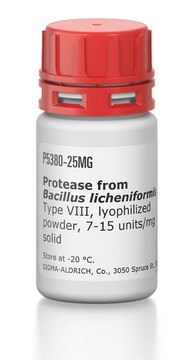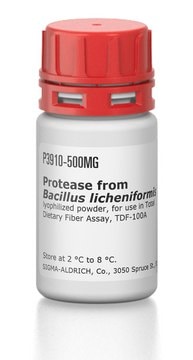推荐产品
應用
胰酶是由猪胰腺的外分泌细胞产生的几种消化酶的混合物。它是由淀粉酶、胰蛋白酶、脂肪酶、核糖核酸酶和蛋白酶组成的广谱蛋白酶。 它被用于 体内 消化性分析。产品P7545已可用于测定纤维素分解菌抑制剂的敏感性。
该酶与淀粉糖苷酶联用,用于食品样品中淀粉的 体外 消化。Sigma的胰酶已可用于 体外 胃蛋白酶-胰酶消化试验,同时利用瘤胃饲料残渣估计较低的肠道消化率。它还与胃蛋白酶一起被用于模拟 体外 猪胃和回肠对原料的消化。
生化/生理作用
由于胰蛋白酶、淀粉酶和脂肪酶等酶的作用,胰酶可水解蛋白质、淀粉和脂肪。 胰酶能在40°C的水中在5分钟内将不少于其25倍重量的土豆淀粉转化为可溶性碳水化合物,可在40℃,pH7.5条件下,在60分钟内消化不少于自身重量25倍的酪蛋白并可在37℃,pH9.0条件下,从橄榄油中每分钟每毫克胰酶释放不少于2微当量的酸。
胰酶由猪胰腺的外分泌细胞产生,含有胰蛋白酶、淀粉酶和脂肪酶、核糖核酸酶和蛋白酶等酶组份。 这种酶的组合使其能够水解蛋白质、淀粉和脂肪。 在 40°C 水中,胰酶在 5 分钟内将不少于其重量 25 倍的马铃薯淀粉转化为可溶性碳水化合物,在 pH7.5,40℃ 下,胰酶在 60 分钟内消化不少于重量 25 倍的酪蛋白,在 pH9.0,37℃ 下,每毫克胰酶每分钟将从橄榄油中释放不低于微当量的酸。
訊號詞
Danger
危險分類
Eye Irrit. 2 - Resp. Sens. 1 - Skin Irrit. 2 - Skin Sens. 1 - STOT SE 3
標靶器官
Respiratory system
儲存類別代碼
11 - Combustible Solids
水污染物質分類(WGK)
WGK 1
其他客户在看
Carbon balances for in vitro digestion and fermentation of potential roughages for pregnant sows.
Becker, P. M., et al.
Anim. Feed Sci. Technol., 110(1), 159-174 (2003)
Yan Li et al.
Food chemistry, 221, 1151-1157 (2016-12-17)
Homologous and heterologous cross-linked polymers of whey protein isolate (WPI), soy protein isolate (SPI) and casein (CN) and their binary mixtures, viz., WPI+SPI, WPI+CN and SPI+CN, were produced using transglutaminase, and their in vitro IgE reactivity and digestibility under simulated
John A Monro et al.
The British journal of nutrition, 103(2), 295-305 (2009-11-26)
Glycaemic responses to foods reflect the balance between glucose loading into, and its clearance from, the blood. Current in vitro methods for glycaemic analysis do not take into account the key role of glucose disposal. The present study aimed to
Estimation of ruminal degradation and intestinal digestion of tropical protein resources using the nylon bag technique and the three-step in vitro procedure in dairy cattle on rice straw diets.
Promkot, C., M. Wanapat, and P. Rowlinson
Asian-Australasian Journal of Animal Sciences, 20(12), 1849-1849 (2007)
J Chen et al.
Microbiology (Reading, England), 147(Pt 1), 21-30 (2001-02-13)
Competition among three species of ruminal cellulolytic bacteria - Fibrobacter succinogenes S85, Ruminococcus flavefaciens FD-1 and Ruminococcus albus 7 - was studied in the presence or absence of the non-cellulolytic ruminal bacteria Selenomonas ruminantium or Streptococcus bovis. Co-cultures were grown
我们的科学家团队拥有各种研究领域经验,包括生命科学、材料科学、化学合成、色谱、分析及许多其他领域.
联系技术服务部门











